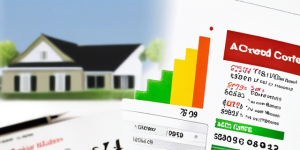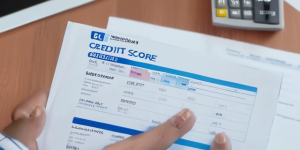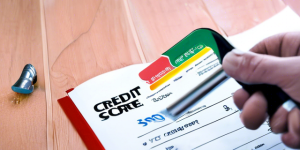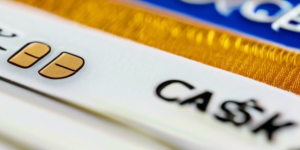
Are you dreaming of owning your own home but worried that your credit score might not be up to par? Don’t fret, my friend! Improving your credit score for a mortgage is a journey, but with the right strategies and determination, you can boost those numbers and make your homeownership dreams a reality.
The Importance of a Good Credit Score
Before we dive into the nitty-gritty, let me ask you a question: why is a good credit score so crucial when it comes to obtaining a mortgage? Well, my dear reader, your credit score is like a report card that lenders use to evaluate your creditworthiness. A higher score tells them that you’re a responsible borrower who is likely to repay your loans on time, while a lower score raises red flags.
Lenders want to minimize their risk, and a strong credit score gives them the confidence they need to offer you better interest rates and loan terms. Trust me; a few points can make a massive difference in how much you’ll pay over the life of your mortgage.
Understanding Your Credit Score

Now, let’s demystify this credit score business. Your credit score typically ranges from 300 to 850, with higher numbers indicating a better credit history. Generally, a score of 700 or above is considered good, while a score above 760 is excellent.
But what factors determine your score? Well, buckle up because it’s a bit of a rollercoaster ride. Your payment history (35% of your score), amount of debt (30%), length of credit history (15%), types of credit (10%), and new credit inquiries (10%) all play a role.
Checking Your Credit Report
Before you can start improving your credit score, you need to know where you stand. That’s why it’s essential to obtain a copy of your credit report from the three major credit bureaus: Experian, Equifax, and TransUnion. You can get a free report from each bureau once a year at AnnualCreditReport.com.
Comb through those reports like a detective, looking for any errors or inaccuracies that could be dragging down your score. If you find any, dispute them immediately with the credit bureaus. It’s your right to have accurate information on your report, and fixing mistakes can give your score a nice boost.
Paying Down Debt

One of the most effective ways to improve your credit score is to tackle your debt head-on. Lenders love to see a low debt-to-income ratio, which shows that you’re not overextended. But how do you go about paying down debt? Here are a few strategies:
- Prioritize high-interest debt: Credit card balances with sky-high interest rates can quickly spiral out of control. Focus on paying off those debts first to save money and improve your credit utilization ratio (the amount of credit you’re using compared to your credit limits).
- Negotiate better rates: Don’t be afraid to pick up the phone and negotiate with your creditors. They may be willing to lower your interest rates or set up a more manageable payment plan, especially if you’ve been a reliable customer.
- Consolidate your debt: If you have multiple debts with varying interest rates, consider consolidating them into a single loan with a lower interest rate. This can make repayment more manageable and potentially save you money in the long run.
- Seek professional help: If your debt situation feels overwhelming, don’t hesitate to seek help from a reputable credit counseling agency. They can help you develop a personalized debt management plan and even negotiate with creditors on your behalf.
Building Positive Credit History
While paying down debt is crucial, you also need to build a positive credit history to boost your score. Here’s how you can do that:
- Make payments on time: Late or missed payments can do serious damage to your credit score. Set up automatic payments or payment reminders to ensure that you never miss a due date.
- Keep credit card balances low: Ideally, you want to keep your credit utilization ratio below 30%. This demonstrates that you’re using credit responsibly and not maxing out your cards.
- Become an authorized user: If you have a family member or friend with a long, positive credit history, ask them to add you as an authorized user on one of their credit cards. This can help establish credit history for you and improve your score.
- Apply for a secured credit card: If you’re starting from scratch or have had credit issues in the past, a secured credit card can be a great way to build or rebuild your credit. You’ll need to put down a refundable security deposit, but making on-time payments can help boost your score.
Monitoring Your Progress
Rome wasn’t built in a day, and neither is a stellar credit score. Improving your credit takes time and consistency, so it’s essential to monitor your progress regularly. Here’s how you can do that:
- Check your credit reports periodically: Keep an eye on your credit reports from all three bureaus to ensure that your efforts are paying off and that no new errors or inaccuracies have crept in.
- Use credit monitoring services: Many companies offer credit monitoring services that can alert you to changes in your credit report and score. This can be a convenient way to stay on top of your progress without having to check your reports manually.
- Be patient and persistent: Remember, improving your credit score is a marathon, not a sprint. Stick to your plan, and trust that your hard work will pay off in the long run.
Other Tips for Improving Your Credit Score

While paying down debt, building positive credit history, and monitoring your progress are the main pillars of credit score improvement, there are a few other tips that can help you along the way:
- Limit hard inquiries: Each time you apply for new credit, the lender will perform a hard inquiry on your credit report, which can temporarily lower your score. Limit these inquiries to only when you absolutely need new credit.
- Avoid closing old accounts: Closing old credit accounts can negatively impact your credit history length and credit utilization ratio. It’s generally better to keep them open, even if you’re not using them actively.
- Consider credit counseling: If you’re struggling with debt or have a particularly complex credit situation, seeking guidance from a reputable credit counseling agency can be invaluable.
Conclusion
Improving your credit score for a mortgage might seem like a daunting task, but with dedication and the right strategies, it’s absolutely achievable. Remember, a higher credit score not only increases your chances of being approved for a mortgage but also gives you access to better interest rates and loan terms, potentially saving you thousands of dollars over the life of your loan.
So, take a deep breath, roll up your sleeves, and get to work. Pay down debt, build positive credit history, monitor your progress, and don’t be afraid to seek help when you need it. Before you know it, you’ll be holding the keys to your dream home, all thanks to your hard work and a stellar credit score.
FAQs
- How long does it take to improve your credit score? The time it takes to improve your credit score can vary depending on your current situation and the steps you take. Generally, you can see significant improvements within 6 to 12 months of consistently practicing good credit habits, but it may take longer if you have more serious credit issues to address.
- What is the minimum credit score needed for a mortgage? While there is no universal minimum credit score requirement for a mortgage, most lenders prefer to see a score of at least 620 for conventional loans and 500-580 for FHA loans. However, higher scores will typically qualify you for better interest rates and loan terms.
- Can I get a mortgage with a credit score below 620? It is possible to get a mortgage with a credit score below 620, but your options may be more limited, and you may have to explore alternative lending options such as FHA loans, VA loans, or subprime lenders. However, these loans often come with higher interest rates and stricter requirements.
- How often should I check my credit report? It’s generally recommended to check your credit report from all three major credit bureaus (Experian, Equifax, and TransUnion) at least once a year. This will allow you to identify and dispute any errors or inaccuracies that could be negatively impacting your credit score.
- Can closing unused credit cards improve my credit score? Closing unused credit cards can actually hurt your credit score in some cases. This is because closing accounts can decrease your overall credit limit and increase your credit utilization ratio, which is a significant factor in determining your credit score. It’s generally better to keep unused accounts open and active, even if you’re not using them regularly.

Maintaining a good credit score is crucial in today’s financial landscape. Your credit score can determine your ability to secure loans, rent an apartment, or even land a job. If your credit score has taken a hit due to missed payments, debt, or other financial mishaps, it’s essential to take steps to repair it. In this comprehensive guide, we’ll walk you through effective strategies to get your credit back on track.
Understanding Your Credit Score

Before we dive into the repair process, let’s briefly discuss what a credit score is and why it matters. Your credit score is a three-digit number that ranges from 300 to 850, calculated based on your credit history and financial behavior. Lenders and creditors use this score to evaluate your creditworthiness and determine the risk of lending to you.
A higher credit score generally indicates a lower risk, making it easier for you to obtain loans, credit cards, and favorable interest rates. Conversely, a lower credit score may result in loan denials, higher interest rates, or stricter terms and conditions.
Factors That Affect Your Credit Score

Several factors contribute to your credit score, including:
- Payment History: This is the most significant factor, accounting for approximately 35% of your score. Late or missed payments can severely damage your credit score.
- Credit Utilization: This refers to the amount of credit you’re using relative to your total available credit. Experts recommend keeping your credit utilization below 30% for a positive impact on your score.
- Length of Credit History: A longer credit history, with a mix of different types of credit (e.g., credit cards, loans, etc.), can benefit your score.
- Credit Mix: Having a diverse mix of credit types, such as revolving credit (credit cards) and installment loans (auto loans, mortgages), can improve your score.
- New Credit: Opening too many new credit accounts in a short period can temporarily lower your score.
Step 1: Obtain Your Credit Reports
The first step in repairing your credit is to obtain copies of your credit reports from the three major credit bureaus: Experian, Equifax, and TransUnion. You can request a free copy of your credit report from each bureau once a year through AnnualCreditReport.com.
Carefully review your reports for any errors, inaccuracies, or fraudulent activities. Errors on your credit report can significantly impact your score, so it’s essential to identify and dispute them.
Step 2: Dispute Errors and Inaccuracies
If you find any errors or inaccuracies in your credit reports, you should dispute them with the respective credit bureaus. Each bureau has a process for filing disputes, which typically involves submitting a written request along with supporting documentation.
Provide clear explanations and evidence to support your dispute, such as bank statements, cancelled checks, or other relevant documents. The credit bureaus are legally obligated to investigate your dispute and correct any errors.
Step 3: Negotiate with Creditors
If you have outstanding debts or accounts in collections, consider negotiating with your creditors. Many creditors are willing to work with you, especially if you’ve experienced financial hardship due to job loss, medical bills, or other extenuating circumstances.
Reach out to your creditors and explain your situation. Propose a payment plan or settlement offer that you can realistically afford. If they agree, get the agreement in writing before making any payments.
Step 4: Develop a Payment Strategy
Once you’ve identified any errors and negotiated with creditors, it’s time to develop a payment strategy. Prioritize paying off your debts, starting with those that have the most significant impact on your credit score.
Focus on making at least the minimum payments on time for all your accounts. If possible, pay more than the minimum to reduce your outstanding balances faster. Consider debt consolidation or balance transfer options to simplify your payments and potentially lower interest rates.
Step 5: Build Positive Credit History
As you work on paying off your debts, it’s also essential to build positive credit history. One effective way to do this is by obtaining a secured credit card or becoming an authorized user on someone else’s credit card account (with their permission).
Use your credit card responsibly by keeping your credit utilization low and making payments on time. Over time, this positive behavior will be reflected in your credit score.
Step 6: Monitor Your Progress
Repairing your credit score is a gradual process, and it’s essential to monitor your progress regularly. Check your credit reports periodically to ensure that errors have been corrected and that your payment history is accurately reflected.
Many credit monitoring services, such as Credit Karma or Credit Sesame, offer free credit score updates and insights into the factors affecting your score.
Conclusion: Ultimate Guide on How to Repair Your Credit Score 2024

Repairing your credit score requires patience, discipline, and a consistent effort. By following the steps outlined in this guide, you can take control of your financial situation and work towards achieving a better credit score.
Remember, a good credit score not only opens doors to better lending opportunities but also serves as a reflection of your financial responsibility. Stick to your plan, remain diligent, and celebrate each milestone along the way. With time and dedication, you can rebuild your credit and pave the way for a brighter financial future.
FAQs: Ultimate Guide on How to Repair Your Credit Score 2024
- How long does it take to repair a credit score? The time it takes to repair a credit score can vary depending on the specific factors affecting your credit. Generally, it can take several months to a year or more to see significant improvements, as negative items typically remain on your credit report for up to seven years.
- Can I completely remove negative items from my credit report? It’s challenging to remove legitimate negative items, such as late payments or defaulted accounts, from your credit report before the designated time frame (usually 7 years). However, you can dispute and remove any inaccurate or fraudulent information.
- How often should I check my credit report? It’s advisable to check your credit reports from all three major credit bureaus (Experian, Equifax, and TransUnion) at least once a year. This helps you identify any errors or potential signs of identity theft early on.
- Can closing unused credit cards help improve my credit score? Closing unused credit cards can potentially hurt your credit score in the short term, as it reduces your total available credit and increases your credit utilization ratio. It’s generally better to keep unused cards open and use them occasionally to maintain a positive credit history.
- Are credit repair companies worth the cost? While credit repair companies can assist with the credit repair process, they typically charge upfront fees. Many of the services they offer, such as disputing errors and negotiating with creditors, can be done by individuals on their own for free. It’s essential to research and choose a reputable credit repair company if you decide to use one.

Hey there, savvy spender! Are you tired of missing out on the sweet rewards that come with using a top-notch cash back credit card? Well, buckle up because we’re about to embark on a journey to discover the crème de la crème of cash back cards for April 2024.
Now, I know what you’re thinking – “But there are so many options out there, how do I choose?” Fear not, my friend, because I’ve done the legwork for you. In this comprehensive guide, we’ll dive deep into the world of cash back credit cards, exploring the nitty-gritty details and helping you find the perfect plastic companion for your spending habits.
Why Cash Back Cards Are a Wise Choice
Let’s start with the basics. Cash back credit cards are like having a personal money-printing machine in your wallet (minus the legal complications, of course). With every swipe or online purchase, you earn a percentage of the transaction amount back in cold, hard cash. It’s like getting a little reward for simply doing something you’d be doing anyway – spending money.
But wait, there’s more! Most cash back cards these days come with lucrative sign-up bonuses, offering a generous chunk of cash just for meeting a minimum spending requirement within the first few months of opening your account. Talk about a warm welcome!
Factors to Consider When Choosing a Cash Back Card

Now that we’ve established the allure of cash back cards, let’s dive into the factors you should consider when choosing the right one for your needs.
1. Earning Categories and Rates
Cash back cards often offer higher reward rates for specific spending categories like gas, groceries, dining out, or travel. Identify your biggest expenditure areas and look for cards that offer the highest cash back rates in those categories. This way, you can maximize your earnings on the purchases you make most often.
2. Sign-Up Bonuses
As mentioned earlier, sign-up bonuses can be a game-changer. Look for cards offering enticing welcome offers, but be mindful of the spending requirements and time frames involved. After all, you don’t want to overspend just to snag that bonus.
3. Annual Fees
Some cash back cards charge an annual fee, while others are fee-free. Consider your spending habits and calculate whether the potential cash back earnings outweigh the annual fee. If you’re a high spender, an annual fee card might be worth it; if not, opt for a no-fee option.
4. Redemption Options
How you can redeem your cash back rewards is also crucial. Some cards offer statement credits, while others allow you to redeem for gift cards, merchandise, or even travel. Choose a card that aligns with your preferred redemption method.
5. Additional Perks and Benefits
Don’t forget to consider extras like purchase protection, extended warranties, and travel benefits. These added perks can provide valuable coverage and save you money in the long run.
Now that we’ve covered the key factors, let’s dive into the best cash back credit cards of April 2024.
Best for Everyday Spending: Citi Double Cash Card

If you’re looking for a straightforward, no-frills cash back card with an excellent earning rate, the Citi Double Cash Card is a strong contender. Here’s what makes it stand out:
- Earning Rate: 2% cash back on all purchases – 1% when you buy, and another 1% when you pay your bill. No complicated categories to keep track of.
- Sign-Up Bonus: None (but you don’t need one with that fantastic flat earning rate).
- Annual Fee: $0
- Redemption Options: Statement credits, direct deposit, or a check in the mail.
This card is perfect for those who value simplicity and want to earn cash back on every purchase without jumping through hoops.
Best for Groceries: Blue Cash Preferred® Card from American Express
Calling all foodies and grocery gurus! If your monthly budget is dominated by trips to the supermarket, the Blue Cash Preferred® Card from American Express should be on your radar.
- Earning Rate: 6% cash back at U.S. supermarkets (up to $6,000 per year, then 1%), 6% cash back on select U.S. streaming services, 3% back at U.S. gas stations and on transit, and 1% back on other purchases.
- Sign-Up Bonus: Earn a $350 statement credit after you spend $3,000 in purchases within the first 6 months.
- Annual Fee: $95
- Redemption Options: Statement credits, gift cards, or merchandise.
With its generous rewards at supermarkets and streaming services, this card is a must-have for families and binge-watchers alike. Just be mindful of the annual fee and make sure your grocery and streaming expenditures justify it.
Best for Dining and Entertainment: Capital One SavorOne Cash Rewards Credit Card
Are you a self-proclaimed foodie who loves exploring new restaurants and indulging in entertainment? Look no further than the Capital One SavorOne Cash Rewards Credit Card.
- Earning Rate: 3% cash back on dining and entertainment, 2% back at grocery stores, and 1% back on all other purchases.
- Sign-Up Bonus: Earn a one-time $200 cash bonus after you spend $500 on purchases within the first 3 months.
- Annual Fee: $0
- Redemption Options: Statement credits, bank account deposits, or gift cards.
With its generous rewards on dining, entertainment, and groceries, this card is a dream come true for those who love to wine, dine, and have a good time. Plus, with no annual fee, it’s a no-brainer addition to your wallet.
Best for Gas and Commuting: Bank of America® Cash Rewards Credit Card
If your daily commute involves hitting the open road and filling up at the pump, the Bank of America® Cash Rewards Credit Card is worth considering.
- Earning Rate: 3% back in the category of your choice (gas, online shopping, dining, travel, drug stores, or home improvement/furnishings), 2% back at grocery stores and wholesale clubs, and 1% back on other purchases.
- Sign-Up Bonus: Earn a $200 online cash rewards bonus after making at least $1,000 in purchases in the first 90 days.
- Annual Fee: $0
- Redemption Options: Statement credits, direct deposit, or a contribution to an eligible Bank of America account.
The ability to choose your 3% cash back category makes this card incredibly flexible, allowing you to maximize your earnings based on your spending habits. Plus, with no annual fee, it’s a low-risk, high-reward option.
Best for Rotating Categories: Chase Freedom Flex℠ Credit Card
If you’re a rewards maximizer who loves to chase after the best cash back opportunities, the Chase Freedom Flex℠ Credit Card is right up your alley.
- Earning Rate: 5% cash back on rotating quarterly bonus categories (upon activation, up to $1,500 in combined purchases per quarter), 5% back on travel purchased through Chase Ultimate Rewards®, 3% back on dining and drugstore purchases, and 1% back on all other purchases.
- Sign-Up Bonus: Earn a $200 bonus after you spend $500 on purchases in the first 3 months.
- Annual Fee: $0
- Redemption Options: Statement credits, direct deposit, gift cards, or travel through Chase Ultimate Rewards®.
This card keeps things interesting with its rotating 5% cash back categories, allowing you to adjust your spending habits each quarter to maximize your earnings. Just remember to activate the bonus categories every three months to take advantage of the elevated rewards.
Best for Travel and Dining: Chase Sapphire Preferred® Card
For the jet-setters and culinary connoisseurs among us, the Chase Sapphire Preferred® Card is a powerhouse that delivers exceptional value on travel and dining purchases.
- Earning Rate: 5x points on travel purchased through Chase Ultimate Rewards®, 3x points on dining (including eligible delivery services and takeout), and 2x points on all other travel purchases.
- Sign-Up Bonus: Earn 60,000 bonus points after you spend $4,000 on purchases in the first 3 months. That’s worth $750 when redeemed for travel through Chase Ultimate Rewards®.
- Annual Fee: $95
- Redemption Options: Travel booked through Chase Ultimate Rewards®, statement credits, direct deposit, gift cards, or merchandise.
With its generous earning rates on travel and dining, plus the incredible sign-up bonus, this card is a must-have for frequent flyers and foodies alike. Just be sure to take advantage of the bonus categories to maximize your point earnings.
Best for Small Businesses: Ink Business Cash® Credit Card
Attention, small business owners! If you’re looking for a cash back card that caters specifically to your entrepreneurial needs, the Ink Business Cash® Credit Card from Chase is a top contender.
- Earning Rate: 5% cash back on the first $25,000 spent in combined purchases at office supply stores and on internet, cable, and phone services each account anniversary year, 2% cash back on the first $25,000 spent in combined purchases at gas stations and restaurants each account anniversary year, and 1% cash back on all other purchases.
- Sign-Up Bonus: Earn $750 bonus cash back after you spend $7,500 on purchases in the first 3 months.
- Annual Fee: $0
- Redemption Options: Statement credits, direct deposit, gift cards, or travel through Chase Ultimate Rewards®.
With its generous earning categories tailored to small business owners’ needs and a substantial sign-up bonus, this card is a no-brainer for entrepreneurs looking to maximize their cash back rewards on essential business expenses.
Best for Students: Discover it® Student Cash Back
Hey, college kids and recent grads! Don’t think we’ve forgotten about you. The Discover it® Student Cash Back card is a fantastic option for building credit while earning rewards.
- Earning Rate: 5% cash back on rotating quarterly categories (upon activation, up to $1,500 in combined purchases per quarter), 1% back on all other purchases.
- Sign-Up Bonus: Discover will match all the cash back you’ve earned at the end of your first year, automatically.
- Annual Fee: $0
- Redemption Options: Statement credits, direct deposit, or gift cards.
Not only does this card offer the opportunity to earn cash back on rotating categories, but Discover also sweetens the deal by matching your first year’s cash back earnings. Talk about a student-friendly perk! Plus, with no annual fee, it’s an excellent way to build credit without breaking the bank.
Best for Building Credit: Petal® 2 Cash Back, Visa® Credit Card
If you’re working on building or rebuilding your credit, the Petal® 2 Cash Back, Visa® Credit Card is a great choice that doesn’t require a traditional credit history.
- Earning Rate: 1% cash back on eligible purchases right away, and 1.5% cash back after making 12 on-time monthly payments. 2% – 10% cash back at select merchants.
- Sign-Up Bonus: None
- Annual Fee: $0
- Redemption Options: Statement credits or check.
While the earning rates may not seem overwhelming, this card stands out for its accessibility to those with limited or no credit history. Plus, with no annual fee, it’s a low-risk way to establish or improve your credit score while earning some cash back along the way.
Best for Flat-Rate Earnings: Citi® Double Cash Card
Sometimes, simplicity is key. If you’re looking for a no-fuss cash back card that offers a solid flat rate on all purchases, the Citi® Double Cash Card is a fantastic choice.
- Earning Rate: 2% cash back on all purchases – 1% when you buy, and another 1% when you pay your bill.
- Sign-Up Bonus: None
- Annual Fee: $0
- Redemption Options: Statement credits, direct deposit, or a check in the mail.
With its straightforward earning structure and no annual fee, this card is perfect for those who prefer a hassle-free approach to earning cash back rewards. No need to worry about rotating categories or complex spending requirements – just use your card and earn a solid 2% back on every purchase.
Maximizing Your Cash Back Earnings
Now that you’re armed with knowledge about the best cash back credit cards of April 2024, it’s time to discuss some strategies to help you maximize your earnings.
1. Pay Your Balance in Full Each Month
One of the golden rules of using cash back credit cards is to pay your balance in full each month. This way, you avoid accruing interest charges that can quickly negate the value of your cash back rewards. Treat your card like a debit card, and only spend what you can afford to pay off when the bill comes due.
2. Pair Cards for Maximum Rewards
Don’t be afraid to mix and match cash back cards to take advantage of their respective bonus categories. For example, you could use one card for gas and groceries, another for dining and entertainment, and a third for all other purchases. This strategy allows you to earn the highest possible cash back rate on every transaction.
3. Utilize Shopping Portals
Many card issuers offer online shopping portals where you can earn additional cash back or bonus points by clicking through to your favorite retailers. Before making an online purchase, check if your card issuer has a shopping portal and take advantage of the extra rewards.
4. Leverage Sign-Up Bonuses
Sign-up bonuses can provide a substantial boost to your cash back earnings, especially in the first year of card ownership. Be sure to meet the minimum spending requirements within the specified time frame to qualify for these lucrative offers.
5. Consider Your Annual Fees
While some cash back cards charge annual fees, the potential rewards can often outweigh the cost – especially if you’re a high spender. Calculate your estimated annual cash back earnings to determine if the fee is worth it for your spending habits.
Conclusion
Phew, we’ve covered a lot of ground, haven’t we? From flat-rate earners to category-specific cards, rotating bonuses, and everything in between, the cash back credit card landscape for April 2024 is as diverse as it is rewarding.
Remember, the key to maximizing your cash back earnings is to choose cards that align with your spending habits and lifestyle. Whether you’re a frequent traveler, a die-hard foodie, or someone who values simplicity above all else, there’s a cash back card out there that’s perfect for you.
So, what are you waiting for? Dust off that wallet and get ready to start earning some serious cash back on your everyday purchases. Happy swiping, and may the rewards be ever in your favor!
FAQs
1. Can I have multiple cash back credit cards? Absolutely! In fact, pairing different cash back cards can be an effective strategy to maximize your rewards across various spending categories. Just be mindful of annual fees and make sure you can responsibly manage multiple credit accounts.
2. How do I redeem my cash back rewards? Redemption options vary by card issuer, but common methods include statement credits, direct deposits into your bank account, gift cards, and even travel bookings through the issuer’s rewards portal. Check your card’s terms and conditions for specific redemption details.
3. Are cash back rewards taxable? Generally, cash back rewards are considered a rebate or discount on purchases, and are therefore not considered taxable income by the IRS. However, it’s always a good idea to consult a tax professional for personalized advice.
4. Can I transfer my cash back rewards to someone else? Unfortunately, most card issuers do not allow you to transfer cash back rewards to another person’s account. The rewards are
]]>